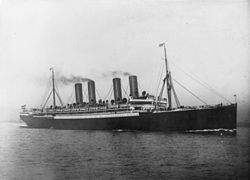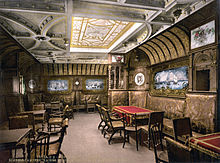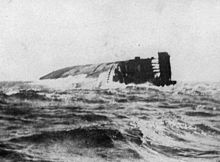Kaiser Wilhelm the Great (ship)
|
The Kaiser Wilhelm the Great in the Atlantic
|
||||||||||||||||||
|
||||||||||||||||||
|
||||||||||||||||||
|
||||||||||||||||||
|
||||||||||||||||||
The Kaiser Wilhelm der Grosse , named after Kaiser Wilhelm I , was a 1897 of completed Doppelschrauben- Schnelldampfer of the North German Lloyd for the liner shipping on the transatlantic passage Bremerhaven-New York. The passenger ship was the bearer of the Blue Ribbon from 1897 to 1900 .
With its four chimneys, it embodied the most popular and spectacular type of ship at the time, which combined the latest technical developments with speed and luxury. The Kaiser Wilhelm der Große was the first German ship to win the Blue Ribbon for the fastest North Atlantic crossing and was in service until 1914. After the outbreak of the First World War , the Imperial Navy converted it into an auxiliary cruiser and used it in the trade war off the West African coast. In 1914 it was sunk by its own crew after a battle with a British cruiser.
A main focus was on the safety equipment. The number of watertight bulkheads had been increased to 18 for the first time and was designed much more heavily than usual.
The most significant feature, however, were the four chimneys with which the North German Lloyd created a completely new class of express steamers that was copied worldwide.
history

After Norddeutsche Lloyd acquired the world's largest fleet of fast steamers with eleven ships over the course of time , it was foreseeable that the single-screw ships were technically outdated and too small to be competitive in the foreseeable future compared to their international competition. The Board decided to take a significant step forward in speed and dimensions. However, the lock in Bremerhaven prevented the purchase or construction of larger ships. Only when the dimensions of the lock were changed because the North German Lloyd threatened to postpone the handling of the express steamers, the way was clear for the construction of larger passenger ships . The German Kaiser Wilhelm II used his influence to have the ship built at a German shipyard.
The ship was laid down on the keel of AG "Vulcan" in Stettin in 1896 , launched on May 4, 1897 and began its maiden voyage from Bremerhaven to New York on September 19, 1897 . The board of directors of Lloyd subsequently emphasized the ship's “extremely successful construction” and “excellent performance”.
In November 1897 the Kaiser Wilhelm the Great broke the record for the eastward transatlantic voyage and four months later for the westward crossing. With this she undercut the previous record of the Cunard liner RMS Lucania . In July 1900, Germany took the eastward record from the HAPAG shipping company, and in September 1903 also the westward record. The loss of the Blue Ribbon to the German ships finally prompted the Cunard Line to build their new express steamers RMS Mauretania and RMS Lusitania , which, in contrast to German ships, could only be built with large subsidies from the British Admiralty and also served the new type of propulsion Practically testing turbines for the Royal Navy in a large ship.
The Kaiser Wilhelm der Große was the first passenger steamer with a commercial facility for radio telegraphy ; this was installed in February 1900 by Marconi's Wireless Telegraph Company .
As on every Lloyd steamer, the Kaiser Wilhelm der Große also carried a licensed doctor who cared for all patients free of charge.
Accidents, miscellaneous
On June 30, 1900, the Kaiser Wilhelm the Great escaped the major fire of the pier in Hoboken with minor damage . The fire destroyed the entire docking facility of the North German Lloyd in the New York harbor, with the passenger ships Main , Bremen and Saale burned out. Around 300 people died, including 161 crew members.
In November 1906 she was rammed amidships by the RMS Orinoco when she was cruising in its fairway off the Orinoco . She suffered a 21 × 8 meter leak and five of her passengers died. A maritime tribunal of the Admiralty Court found the guilt completely with the Kaiser Wilhelm the Great .
In 1914, the ship was rebuilt to only carry 3rd and 4th class passengers; this was intended to meet the growing need for space from emigrants to North America.
War action 1914
When the First World War broke out in August 1914, the ship was in Bremerhaven. The Kaiser Wilhelm der Große was taken over by the Imperial Navy and converted into an auxiliary cruiser. In addition, it received a visual protection coating that blurred against the horizon and four 10.5 cm fast-loading cannons.
Frigate Captain Max Reymann (1872–1948) managed to break through the not yet fully closed British blockade belt of the North Sea blockade and to head for the operational area off the west coast of Africa in order to intercept British steamers there. On August 7, the auxiliary cruiser in the Atlantic brought up the British fishing steamer Tubal Cain (227 GRT), which was sunk with explosive cartridges on the same day. The passenger ships Galicean and Atalante were left unmolested, as women and children were on board, whose crossing would have been very laborious. The freight steamers Kaipara (7392 GRT) and Nyanga (3066 GRT) were brought up and sunk on August 16 , while the British coal steamer Arucas with a prize crew was used as a support ship.
On August 17, 1914, Kaiser Wilhelm the Great was supplied with new coal supplies by the Magdeburg and Bethania just two kilometers off the coast of Spanish Sahara near Río de Oro , which lasted a few days. On August 26, the British cruiser HMS Highflyer appeared , which was equipped with six 6-inch guns (15.2 cm), and opened fire on the former express steamer, disregarding Spanish neutrality. After half an hour the German ship had run out of ammunition; only two crew members of the auxiliary cruiser were killed during the highflyer fire . On the orders of the captain, the Kaiser Wilhelm the Great was sunk in the shallow waters by explosive charges. The oldest and probably most famous four-chimney steamer of the Lloyd capsized over the starboard side and remained there sticking out of the water.

The crew landed in three boats and marched a good 12 km through the desert to a Spanish fort, where they were picked up. On August 30, the crew took a Spanish mail steamer to Las Palmas , where they met the utilities Arucas and Bethania . The Bethania set course for Charleston in the neutral United States with 350 men of the auxiliary cruiser crew , but was seized in the Caribbean by the British armored cruiser HMS Essex . The Bethania was escorted to Kingston / Jamaica , where her crew and the crew members of the auxiliary cruiser remained in captivity during the war.
The wreck remained at the sinking site until 1952 or, according to another source, until 1960. Only then was the ship scrapped.
Discovery of wreckage in 2013
In September 2013 the organization “Selam” discovered numerous remains of the Kaiser Wilhelm der Große at the sinking site during a diving expedition . Among other things, a film recording of the well-preserved signature on the bow was made.
The Schnelldampfer class (Kaiserklasse) of the North German Lloyd before 1914
All four steamers in this class had four chimneys with a corresponding propulsion power.
- Kaiser Wilhelm the Great (1897 to 1914; 22.35 kn maximum speed, blue ribbon winner)
- Crown Prince Wilhelm (1901 to 1923; sister ship of the Kaiser Wilhelm the Great; 23.51 kn maximum speed, blue ribbon winner)
- Kaiser Wilhelm II. (1902 to 1940; 23.58 kn maximum speed, blue ribbon winner)
- Crown Princess Cecilie (1907 to 1940; 23.6 kn maximum speed)
swell
- ↑ a b Oswald Flamm (Ed.): Shipbuilding, shipping and port construction. Volume 2/1901, Berlin 1901, p. 509.
- ^ "Norddeutscher Lloyd, Bremen, yearbook", Verlag HM Hauschild, Bremen 1910, p. 63
- ^ Georg Otto Adolf Bessell: "Norddeutscher Lloyd", Verlag C. Schünemann, 1957, p. 200
- ^ Georg Otto Adolf Bessell: Norddeutscher Lloyd , Verlag C. Schünemann, 1957, p. 76
- ↑ Mertens, Eberhard (Ed.): The Lloyd Schnelldampfer. Kaiser Wilhelm the Great, Crown Prince Wilhelm, Kaiser Wilhelm II, Crown Princess Cecilie. Olms Presse, Hildesheim 1975. ISBN 3-487-08110-5 . P. 71
- ↑ werck ship kaiser wilhlem the great in rio de oro ( english , video) Salam association. Accessed May 31, 2019.
- ↑ Mertens, Eberhard (Ed.): The Lloyd Schnelldampfer. Kaiser Wilhelm the Great, Crown Prince Wilhelm, Kaiser Wilhelm II, Crown Princess Cecilie. Olms Presse, Hildesheim 1975. ISBN 3-487-08110-5 . P. 10
literature
- Mertens, Eberhard (ed.): The Lloyd Schnelldampfer. Kaiser Wilhelm the Great, Crown Prince Wilhelm, Kaiser Wilhelm II, Crown Princess Cecilie. Olms Presse, Hildesheim 1975. ISBN 3-487-08110-5
- Bremen Architects and Engineers Association: Bremen and its Buildings , Vol. II. Carl Schünemann Verlag, Bremen 1900.
- Entry: Auxiliary cruiser "Kaiser Wilhelm der Große" , in: Kapitän zur See a. D. Hugo von Waldeyer-Hartz: The cruiser war 1914-1918. The cruiser squadron. Emden, Koenigsberg, Karlsruhe. The auxiliary cruiser , Oldenburg i. O. 1931, pp. 175-179.
- Chapter: SM auxiliary cruiser "Kaiser Wilhelm the Great". In: Eberhard von Mantey : The cruiser war in foreign waters. 3rd vol .: The German auxiliary cruisers. Berlin (published by ES Mittler & Sohn) 1937, pp. 11–24.
- Carl Herbert: War voyages of German merchant ships. Achievements of the merchant navy and their men in World War II. Hamburg (Broschek & Co. publishing house) 1934, pp. 21-25.



